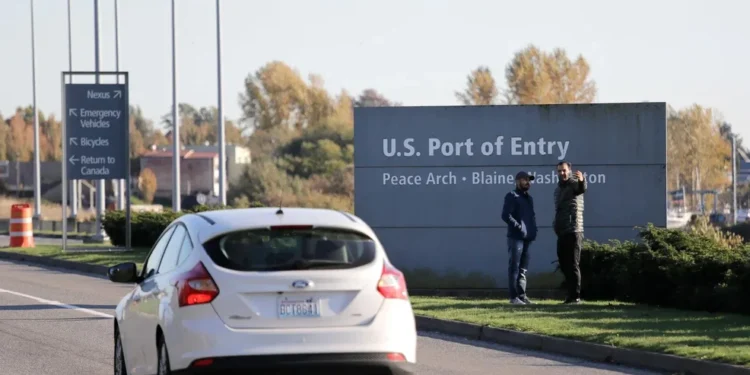A man died last month while in U.S. Customs and Border Protection custody at the Peace Arch Port of Entry in Blaine, Washington, after a car crash and brief foot chase, the agency said Thursday.
According to a CBP news release issued on October 23, the incident occurred around 10:13 p.m. on September 20, when a driver in a white Mercedes-Benz traveled the wrong way on a southbound exit ramp near the U.S.-Canada border.
CBP identified the driver as a U.S. citizen but did not release his name.
Officers saw the car crash into a curb and stop in a grassy area south of the primary inspection lanes. After a CBP officer called 911 to report the accident, the driver got out of the vehicle and ran toward the primary lanes. Officers said they saw a handgun, later identified as a Glock 26, fall from the man’s waist area as he ran.
CBP officers ordered the man to get on the ground. When he did not comply, they detained him after he stumbled and fell. Officers handcuffed him in front of his body and placed leg restraints on him due to what they described as continued resistance.
A search of a fanny pack the man was wearing allegedly revealed cocaine, marijuana, ketamine and a THC vape cartridge.
At 10:19 p.m., officers placed the restrained man in a wheelchair and took him to a secondary inspection area. When officers tried to wake him minutes later and received no response, they called 911 again for medical assistance.
CBP officers said they began CPR and used an automated external defibrillator, but the device did not advise a shock. Emergency medical personnel arrived at 10:42 p.m. and took over lifesaving efforts. The man was pronounced dead at 11:11 p.m.
A preliminary autopsy indicated the man had a major artery blockage, CBP said. The Whatcom County Medical Examiner’s Office is conducting a full examination and toxicology tests.
The CBP Office of Professional Responsibility is reviewing the incident and has notified the Department of Homeland Security’s Office of Inspector General.
The month-long delay between the September 20 death and October 23 public announcement raises transparency questions about CBP’s timeline for disclosing in-custody deaths, with advocacy groups often criticizing federal law enforcement for slow information releases.
The wrong-way driving on a southbound exit ramp near the international border suggests either impairment, medical emergency, or intentional evasion, with the subsequent discovery of multiple drugs supporting theories that the driver was under the influence.
The Glock 26 falling from the man’s waist area during the foot chase indicates concealed carry without proper holstering, creating officer safety concerns that influenced the subsequent detention approach and use of restraints.
The handcuffing in front of the body rather than standard behind-the-back positioning suggests officers recognized medical concerns or the man’s condition warranted modified restraint techniques, though leg restraints indicate continued resistance concerns.
The six-minute window between placing the man in a wheelchair at 10:19 p.m. and discovering him unresponsive minutes later suggests rapid medical deterioration possibly related to the major artery blockage identified in preliminary autopsy findings.
The AED’s decision not to advise shock indicates the man was not experiencing shockable cardiac rhythms like ventricular fibrillation, suggesting other cardiac events like complete blockage or asystole that automated defibrillators cannot treat.
The 23-minute gap between the second 911 call and emergency medical personnel arrival at 10:42 p.m. raises questions about response times to the remote border crossing location, though CBP officers performed CPR during the entire interval.
The cocaine, marijuana, ketamine, and THC vape cartridge combination suggests either personal use or small-scale distribution, with the drug mixture potentially contributing to cardiovascular stress that interacted fatally with the underlying artery blockage.
The Whatcom County Medical Examiner’s full examination and toxicology tests will determine whether drugs, physical exertion during the chase, restraint stress, or the underlying heart condition caused death, findings that could affect CBP liability determinations.
The Department of Homeland Security Office of Inspector General notification triggers independent oversight of the incident, providing external review beyond CBP’s internal Office of Professional Responsibility investigation.







